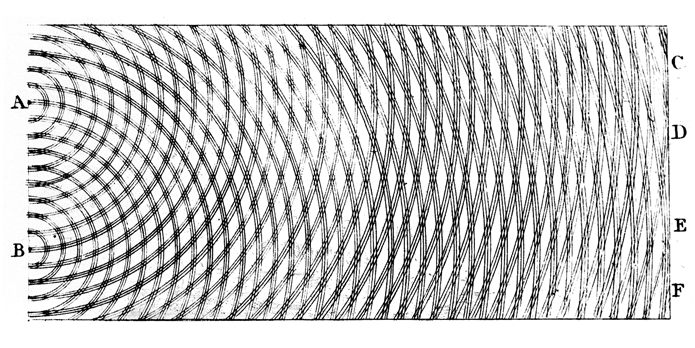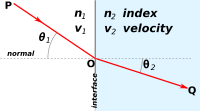The Wavelike Nature of Light
Diffraction, Interference and Refraction Round Out Our Overview of the Behavior of Light
Anonym
In looking at the nature of light, we have seen how light interacting with matter illuminates our world. When light rays fall up some piece of matter, they can be absorbed, reflected, or transmitted. We've seen that the reflection of light is key to how we remotely perceive the universe around us. Light photons that are absorbed by matter add to the energy of the quantum system, and matter may radiate light back out to space. Just with this information, we can say a great deal about the way light behaves. To complete the bigger picture, however, we will need to take a look at how the wavelike nature of light emerges when light flows around and through matter.

The Golden Gate Bridge refracted in rain drops acting as lenses on glass by Brocken Inaglory - Licensed under CC BY-SA 3.0 via Commons
If you've ever been to the ocean and seen water waves bending around the end of a sea wall, or watched as waves spread out from a channel, you've observed the wave phenomenon known as diffraction. Basically, wave energy bends around physical objects that it encounters. While this is easy to observe with mechanical waves in a medium such as water, diffraction of light is very subtle and not easily noticed. Light waves have such small wavelengths (~5000 Angstroms) that the amount of bending that occurs is always very small. However, there is in fact a simple way to observe diffraction of light. When light from a distant source is passed through a small pinhole or slit, what is called a diffraction pattern can be observed. If you've ever seen a distant street light through a fine window screen you may have noticed that the point light source of the street lamp appears to your eyes to form a cross. This is diffraction: the four sides of each tiny hole in the screen act like the side of a diffraction slit, and bends the light four ways to form a cross shape. The fact that diffracted light rays form patterns is due to another feature of general wave phenomena: interference.

Thomas Young's sketch of two-slit diffraction, presented to the Royal Society in 1803 - Public Domain via Commons
Interference is another effect that is easily observed in the realm of mechanical waves. Drop two rocks into slightly different spots of a pond and watch as the resulting waves interact with each other. Waves whose crests and troughs match up with each other in frequency are said to be in-phase. Such waves will interfere with each other constructively, meaning that they will add to each other to produce a wave that, while still of the same frequency, has twice the amplitude (wave height) of the two individual constituent waves. Waves that are completely out of phase with each other (peak lining up with trough and vice-versa) will combine with what is termed destructive interference. The two waves will cancel each other out, resulting in no wave. Interference does not create or destroy wave energy, but rather redistributes it. Thus when light waves are passed through a diffraction slit, the resulting pattern is formed by the diffracted light rays constructively and destructively interfering with each other.

Constructive and destructive interference of two waves by Haade - Licensed under CC BY-SA 3.0 via Commons
When light is able to traverse through matter of some sort, perhaps its most useful behavior emerges. Refraction is the bending of light rays as they travel across the interface between two different materials, such as air and water. The cause of this behavior is that light travels at different speeds through different materials. It is well known that the speed of light is constant in a vacuum, and it doesn't slow down much when traveling through air. But light travels only 3/4 as fast through water and only 2/3 as fast through glass. The slower light travels through a substance, the more it will be bent through refraction.

Snell's Law which describes refraction by Cristan - Public Domain via Commons
Large portions of the science of optics largely proceed from the very simple rules of refraction. Because translucent materials such as glass bend light rays, we can create lenses that manipulate and focus the light that passes through them to serve various purposes. The lenses in eyeglasses, microscopes and telescopes all harness the refractory behavior of light, which is only possible because light observably behaves like all waves do. Of course, light also behaves in some ways as a particle (see the photoelectric effect, for example), but that is a subject for an entirely different article.

Two soap bubbles, illustrating iridescent colors due to thin film interference by Tagishsimon - Licensed under CC BY-SA 3.0 via Commons